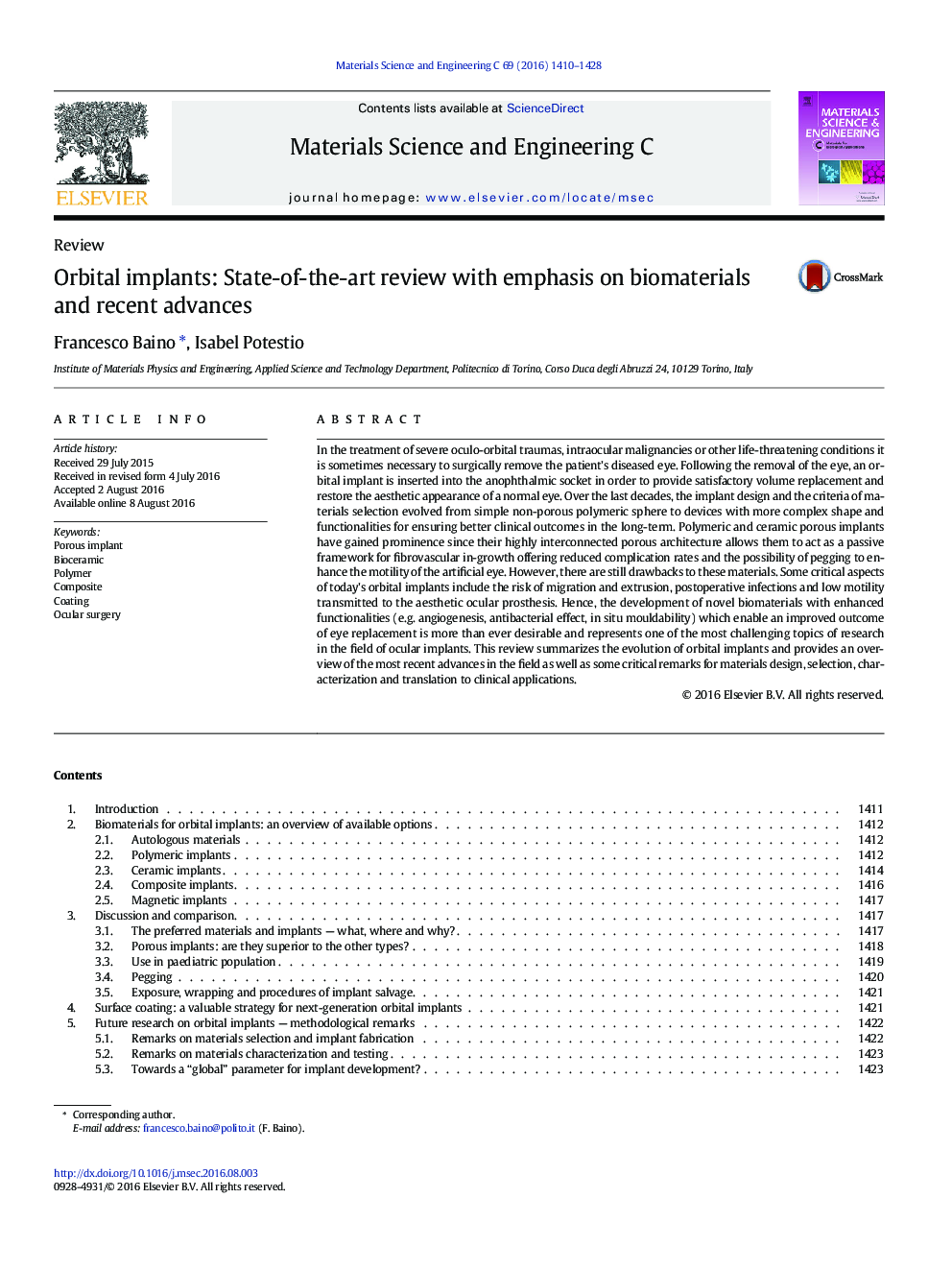| کد مقاله | کد نشریه | سال انتشار | مقاله انگلیسی | نسخه تمام متن |
|---|---|---|---|---|
| 7866785 | 1509152 | 2016 | 19 صفحه PDF | دانلود رایگان |
عنوان انگلیسی مقاله ISI
Orbital implants: State-of-the-art review with emphasis on biomaterials and recent advances
ترجمه فارسی عنوان
ایمپلنت مداری: بررسی پیشرفته کشور با تاکید بر مواد بیولوژیکی و پیشرفت های اخیر
دانلود مقاله + سفارش ترجمه
دانلود مقاله ISI انگلیسی
رایگان برای ایرانیان
کلمات کلیدی
ترجمه چکیده
در درمان شدید آسیب های چشم پزشکی، بیماری های بدخیم داخل چشم یا سایر شرایط تهدید کننده زندگی، گاهی اوقات لازم است که بیمار چشم را از بین ببرد. پس از حذف چشم، یک ایمپلنت مداری به سوکت انوفتالمیک وارد می شود تا جایگزینی حجم مناسب و بازگرداندن ظاهر زیبایی یک چشم طبیعی باشد. در طی دهه های اخیر، طراحی ایمپلنت و معیار انتخاب مواد از کروی ساده و غیر متمرکز به پلیمر به دستگاه هایی با شکل پیچیده تر و قابلیت های بیشتری برای اطمینان از نتایج بالینی بالقوه در بلندمدت تکامل یافته است. ایمپلنتهای متخلخل پلیمری و سرامیکی از آنجا که معماری متخلخل متصل به یکدیگر بسیار متصل هستند، به آنها اجازه می دهد تا به عنوان چارچوب منفعل برای رشد فیبروکوزول در رشد، کاهش میزان عوارض و امکان پیوند به منظور افزایش تحرک چشم مصنوعی را به دست آورند. با این حال، هنوز در مورد این مواد وجود دارد. برخی از جنبه های حیاتی ایمپلنتهای مدرن امروز عبارتند از: خطر مهاجرت و اکستروژن، عفونت های پس از عمل و تحرک کم تحرک پروتزهای چشم انداز زیبایی. از این رو، توسعه مواد زیستی جدید با قابلیت های پیشرفته (به عنوان مثال آنژیوژنز، اثر ضد باکتری، امکان پذیری در محل) که باعث بهبود نتیجه جایگزینی چشم می شود بیشتر از همیشه مطلوب است و نشان دهنده ی یکی از چالش انگیز ترین موضوعات تحقیق در زمینه ایمپلنت های چشم . این بررسی خلاصه ای از تکامل اپیلاسیون های مداری را ارائه می دهد و یک مرور کلی از پیشرفت های اخیر در زمینه و همچنین برخی از اظهارات انتقادی برای طراحی، انتخاب، مشخص کردن و ترجمه به برنامه های کاربردی بالینی ارائه می دهد.
موضوعات مرتبط
مهندسی و علوم پایه
مهندسی مواد
بیومتریال
چکیده انگلیسی
In the treatment of severe oculo-orbital traumas, intraocular malignancies or other life-threatening conditions it is sometimes necessary to surgically remove the patient's diseased eye. Following the removal of the eye, an orbital implant is inserted into the anophthalmic socket in order to provide satisfactory volume replacement and restore the aesthetic appearance of a normal eye. Over the last decades, the implant design and the criteria of materials selection evolved from simple non-porous polymeric sphere to devices with more complex shape and functionalities for ensuring better clinical outcomes in the long-term. Polymeric and ceramic porous implants have gained prominence since their highly interconnected porous architecture allows them to act as a passive framework for fibrovascular in-growth offering reduced complication rates and the possibility of pegging to enhance the motility of the artificial eye. However, there are still drawbacks to these materials. Some critical aspects of today's orbital implants include the risk of migration and extrusion, postoperative infections and low motility transmitted to the aesthetic ocular prosthesis. Hence, the development of novel biomaterials with enhanced functionalities (e.g. angiogenesis, antibacterial effect, in situ mouldability) which enable an improved outcome of eye replacement is more than ever desirable and represents one of the most challenging topics of research in the field of ocular implants. This review summarizes the evolution of orbital implants and provides an overview of the most recent advances in the field as well as some critical remarks for materials design, selection, characterization and translation to clinical applications.
ناشر
Database: Elsevier - ScienceDirect (ساینس دایرکت)
Journal: Materials Science and Engineering: C - Volume 69, 1 December 2016, Pages 1410-1428
Journal: Materials Science and Engineering: C - Volume 69, 1 December 2016, Pages 1410-1428
نویسندگان
Francesco Baino, Isabel Potestio,
